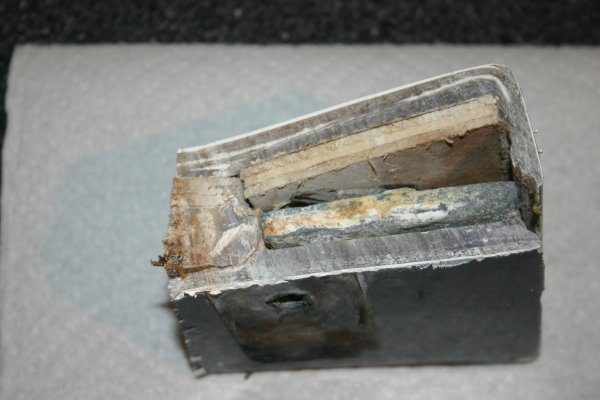Al
Guru
- Joined
- Apr 1, 2012
- Messages
- 2,206
- Location
- usa
- Vessel Name
- 'SLO'~BELLE
- Vessel Make
- 1978 Marben-27' Flybridge Trawler(extended to 30 feet) Pilothouse Pocket Cruiser[
Greetings Forum,
About two months ago I started a thread on ballasting our 27' Marben pocket trawler, There were a couple of posters who wished to be appraised of what action and results were had. Several positive suggestions were made. Of course the most logical solution is lead. Estimates had a weight of 400# to be effective.Cost was the next hurtle. Locally the only commercial access to that weight is with commercial salmon trolling "Cannon Balls". Storage space would accept 8- 50# cannon balls. The cost of each ball is close to $165.00 or $3.30 per #. Sucked it up and was ready to buy when a retired commercial salmon troller hear of my plight and offered the name of another retired fisherman who had in the past, melted down a supply of old lead pipe into 55# ingots. He was willing to sell these ingots at $1.40 per pound. I purchased 13 (715#) and placed them on center line as they would fit where the estimated 400# of cannon balls were destined.
Took the boat out into 2 foot chop with whitecaps and 15 knot wind. Not rough but enough to reflect the wisdom of waiting for the lead ballast to appear. The boat rolls very gently, it has stopped the "Hobby Horse" when in head seas and trails very much improved in following sea. In fact, in the trough the boat rises and falls on keel pretty much with a soft roll.
There the completion of a project.
By the way, not to confuse, we changed the name of our boat from "HAPi" to "SLO'~BELLE. Seems to fit better for a 6 knot boat.
Cheers,
Al Johnson
27'Marben- Ketchikan(Bridge to Nowhere) Alaska
About two months ago I started a thread on ballasting our 27' Marben pocket trawler, There were a couple of posters who wished to be appraised of what action and results were had. Several positive suggestions were made. Of course the most logical solution is lead. Estimates had a weight of 400# to be effective.Cost was the next hurtle. Locally the only commercial access to that weight is with commercial salmon trolling "Cannon Balls". Storage space would accept 8- 50# cannon balls. The cost of each ball is close to $165.00 or $3.30 per #. Sucked it up and was ready to buy when a retired commercial salmon troller hear of my plight and offered the name of another retired fisherman who had in the past, melted down a supply of old lead pipe into 55# ingots. He was willing to sell these ingots at $1.40 per pound. I purchased 13 (715#) and placed them on center line as they would fit where the estimated 400# of cannon balls were destined.
Took the boat out into 2 foot chop with whitecaps and 15 knot wind. Not rough but enough to reflect the wisdom of waiting for the lead ballast to appear. The boat rolls very gently, it has stopped the "Hobby Horse" when in head seas and trails very much improved in following sea. In fact, in the trough the boat rises and falls on keel pretty much with a soft roll.
There the completion of a project.
By the way, not to confuse, we changed the name of our boat from "HAPi" to "SLO'~BELLE. Seems to fit better for a 6 knot boat.
Cheers,
Al Johnson

27'Marben- Ketchikan(Bridge to Nowhere) Alaska
Last edited:




